
The British Fourteenth Army was a multi-national force comprising units from Commonwealth countries during the Second World War. As well as British Army units, many of its units were from the Indian Army and there were also significant contributions from the British Army's West and East African divisions. It was often referred to as the "Forgotten Army" because its operations in the Burma campaign were overlooked by the contemporary press, and remained more obscure than those of the corresponding formations in Europe for long after the war. For most of the Army's existence, it was commanded by Lieutenant-General William Slim.

XXX Corps was a corps of the British Army during the Second World War. The corps was formed in the Western Desert in September 1941. It provided extensive service in the North African Campaign and many of its units were in action at the Second Battle of El Alamein in late 1942. It then took part in the Tunisia Campaign and formed the left flank during the Allied invasion of Sicily in 1943.

The Indian Army during World War II, a British force also referred to as the British Indian Army, began the war, in 1939, numbering just under 200,000 men. By the end of the war, it had become the largest volunteer army in history, rising to over 2.5 million men in August 1945. Serving in divisions of infantry, armour and a fledgling airborne force, they fought on three continents in Africa, Europe and Asia.
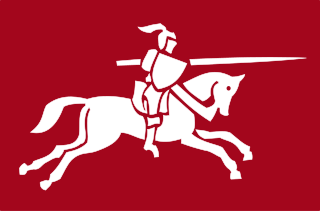
VIII Corps was a British Army corps formation that existed during the First and Second World Wars. In the latter, it took part in the Normandy Campaign in 1944, where it was involved in Operation Epsom and Operation Goodwood. It would later play a supporting role in Operation Market Garden and finish the war by advancing from the Rhine to the Baltic Sea.
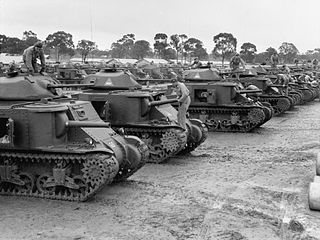
The 1st Armoured Division was an armoured formation of the Australian Army, raised in 1941 as part of the Second Australian Imperial Force (AIF) during World War II. While the Division was originally to be deployed to North Africa in late 1941, it was retained in Australia following the outbreak of the Pacific War. The 1st Armoured Division formed a key element of Australia's defences against a feared Japanese invasion and was disbanded in Western Australia in September 1943.
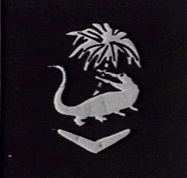
The 4th Armoured Brigade was an armoured formation of the Australian Army established during the Second World War. It was formed in February 1943 to provide armoured support for infantry units operating in the South West Pacific Area. Its composition varied over time, but usually comprised several armoured regiments equipped with Matilda II or M3 Grant tanks as well as some support units.
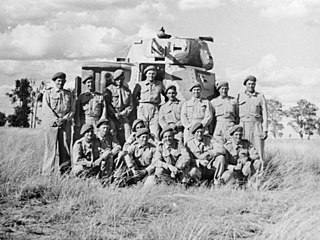
Armoured units made a relatively small, but important, contribution to Australia’s war effort during World War II. While Australia formed three armoured divisions and two independent armoured brigades during the war, Australian armoured units only saw action as independent regiments and companies supporting larger infantry formations. Early actions were fought in the Middle East by the divisional carrier regiments that supported the 6th, 7th and 9th Divisions, fighting in Libya, Egypt and Syria in 1941–42, before the Australian divisions returned to Australia in 1942–43. During the early fighting in the Pacific, there was a limited role for armoured formations, although one armoured regiment – the 2/6th – took part in the fighting around Buna–Gona in late 1942. Later in the war, though, during the Huon Peninsula, Bougainville and Borneo campaigns of 1943–45, several armoured units were used by Australian forces in the infantry support role.
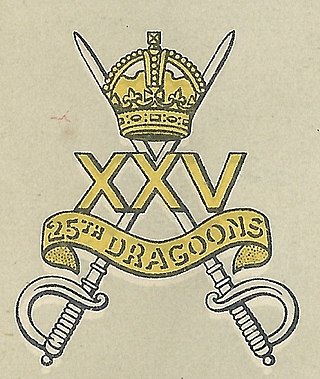
The 25th Dragoons was a cavalry regiment of the British Army from 1941 to 1947.

The 23rd Armoured Brigade, originally formed as the 23rd Army Tank Brigade, was an armoured brigade of the British Army that saw service during the Second World War. The brigade was a 2nd Line Territorial Army (TA) formation. It was reorganised and renamed the 23rd Armoured Brigade, when it was assigned to the 8th Armoured Division, although it never operated under command of the division.

The 22nd Armoured Brigade was an armoured brigade of the British Army that saw service during and after the Second World War. The brigade was formed on the outbreak of war on 3 September 1939 from Territorial Army (TA) armoured regiments. It saw a considerable amount of action during the war, beginning with the Western Desert Campaign where it was engaged in Operation Crusader and at the Battles of Gazala, Mersa Matruh, First Alamein and Alam el Halfa. It then joined the 7th Armoured Division for the Second Battle of El Alamein. It remained part of 7th Armoured for the rest of the war, including the campaigns in Tunisia, Italy and North West Europe. It continued in the postwar TA until 1956. The brigade's identity was re-established in the Regular Army between 1981 and 1993.

The 30th Armoured Brigade was an armoured formation of the British Army that served in Western Europe Campaign as part of the 79th Armoured Division. After the reformation of the Territorial Army in 1947, the brigade was re-created within the Territorials based in Scotland and finally disbanded by 1967.

The 14th Indian Infantry Division was an infantry division of the Indian Army during World War II. It fought in the Arakan Campaign 1942–43, and was subsequently converted into a Training Division, providing drafts of replacements for units of the Fourteenth Army during the Burma Campaign.

The 82nd Division was formed under British control during the Second World War. It took part in the later stages of the Burma Campaign and was disbanded in Burma between May and September 1946.
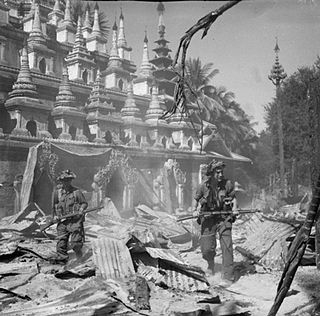
The Burma campaign in the South-East Asian Theatre of World War II was fought primarily by British Commonwealth, Chinese and United States forces against the forces of Imperial Japan, who were assisted by the Burmese National Army, the Indian National Army, and to some degree by Thailand. The British Commonwealth land forces were drawn primarily from the United Kingdom, British India and Africa.
The 254th Indian Tank Brigade was an armoured brigade of the Indian Army during World War II.

At the start of 1939, the British Army was, as it traditionally always had been, a small volunteer professional army. At the beginning of the Second World War on 1 September 1939, the British Army was small in comparison with those of its enemies, as it had been at the beginning of the First World War in 1914. It also quickly became evident that the initial structure and manpower of the British Army was woefully unprepared and ill-equipped for a war with multiple enemies on multiple fronts. During the early war years, mainly from 1940 to 1942, the British Army suffered defeat in almost every theatre of war in which it was deployed. But, from late 1942 onwards, starting with the Second Battle of El Alamein, the British Army's fortunes changed and it rarely suffered another defeat.

The Arakan campaign of 1942–1943 was the first tentative Allied attack into Burma, following the Japanese invasion of Burma earlier in 1942, during the Second World War. The British Army and British Indian Army were not ready for offensive actions in the difficult terrain they encountered, nor had the civil government, industry and transport infrastructure of Eastern India been organised to support the Army on the frontier with Burma. Japanese defenders occupying well-prepared positions repeatedly repulsed the British and Indian forces, who were then forced to retreat when the Japanese received reinforcements and counter-attacked.
149th Regiment Royal Armoured Corps was an armoured regiment of the British Army's Royal Armoured Corps that served in the Burma Campaign during World War II.
The 35th Armoured Brigade was an armoured brigade formation of the British Army, formed during the Second World War. The brigade was never deployed in combat, remaining in the UK to act as a home defence and training unit, and provided replacements for other formations.

The 146th Regiment Royal Armoured Corps was an armoured regiment of the British Army's Royal Armoured Corps that served in India, Burma, and Sumatra during and after World War II. 146 RAC survived the war, and was still active in early 1947.
















